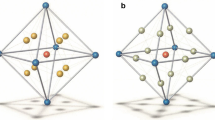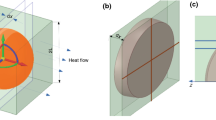Abstract
In this paper, the authors introduce a body-centered polyhedral model capable of simulating the periodic structure of particulate composites, in order to estimate the thermal conductivity of a general class of this type of materials. This model takes into account the arrangement of internal and neighboring particles in the form of three distinct deterministic configurations, along with the concept of interphase on the thermal and mechanical properties of the composite, which is assumed to be macroscopically homogeneous and isotropic. Next, by means of this advanced multilayer model, an explicit analytical expression to evaluate the thermal conductivity of this type of composites is derived. The theoretical predictions were compared with the experimental results found in the literature, as well as with the theoretical values yielded by some reliable formulae derived from other workers, and a reasonable agreement was observed.






Similar content being viewed by others
Change history
23 December 2017
There is a small typo in the Appendix Section.
References
Nielsen LE (1974) Mechanical properties of polymers and composites. Marcel Dekker Inc, New York
Takayanagi M, Harima H, Iwata Y (1963). J Soc Mat Sci Japan (ZAIRYO) 12:129
Takayanagi M, Uemura S, Minami S (1964). J Polym Sci Part C 5:113
Spathis G, Kontou E, Theocaris P (1984). J Rheol 28:161
Takano Y, Sakanishi A (1972). J Phys Soc Japan 32:582
Lipatov Y (1977) Physical chemistry of filled polymers. Khimiya, Moscow
Sideridis E, Theocaris P, Papanicolaou G (1986). Rheol Acta 25:350
Eshelby J (1957) Proceedings of the Royal Society of London. Series A, Math Phys Sci 241:376
Chen H, Acrivos A (1978). Int J Solids and Struct 14:349
Ju J, Chen T (1994). Acta Mech 103:123
Nemat-Nasser S, Iwakuma T, Hejazi M (1982). Mech Mater 1:239
Walker K, Jordan E, Freed A (1990) Equivalence of Green’s function and the Fourier series representation of composites with periodic microstructure. In: Weng GJ, Taya M, Ab CH (eds) Micromechanics and inhomogeneity, The Toshio Mum Anniversary Volume. Springer, New York, pp 535–558
Nunan K, Keller J (1984). Mech Phys Solids 32:259
Sangani A, Lu J (1987). J Mech Phys Solids 35:1
Rodin G (1993). Int J Solids Struct 30:1849
Cohen I, Bergman D (2003). Int J Solids Struct 51:1433
Balch D, Fitzgerald T, Michaud V, Mortensen A, Shen Y, Suresh S (1996). Metall Mater Trans A 27:3700
Yin H, Sun L (2005). Philos Mag Lett 85:163
Roudini G, Tavangar R, Weber L, Mortensen A (2010). Int J Mat Res 101:113
Sideridis E, Venetis J (2014). Int Rev on Model Simul 7:671
Eucken A (1932) Forsch. Gebiete Ingenieurw B3 Forschungsheft 353:16
Bruggeman D (1936). Ann Phys 24:636
Lewis T, Nielsen L (1970). Jnl Apl Pol Sci 14:1449
Lin F, Bhatia G, Ford J (1973). J Appl Polym Sci 49:1901
Khan K, Muliana A (2010). Acta Mech 209:153
Ordonez-Miranda J, Young R, Alvarado-Gil J (2012). J Appl Phys 111:044319
Faroughi S, Huber C (2015). J Appl Phys 117:055104
Kytopoulos V, Sideridis E (2016). JP J Heat and Mass Transfer 13:395
Shen L, Li J (2003). Int J Solids Struct 40:1393
Sideridis E (2016). Composite Interfaces 23:231
Venetis J, Sideridis E (2016). Ind J Pure and Appl Phys 54:313
Garboczi E, Berryman J (2000). Conc Sci and Engin 2:88
Felske J (2004). Int J Heat Mass Trans 47:3453
Karayacoubian, P., Yovanovich, M. and Culham, J. (2006) ‘Thermal resistance – based for bounds for the effective conductivity of composite thermal interface materials. In: 2006 IEEE/CPMT 22nd semiconductor thermal measurement & management symposium, (SEMI-THERM), US
Pan M, Zhang C, Liu B, Mu J (2013). J Mat Sci Res 2:153
Theocaris P, (1987) In: Henrici-Olive G, Olive S (eds) The Mesophase concept in composites, polymers–properties and applications, vol 11. Springer-Verlag, Berlin, Germany
Lipatov Y (1980) The Mesophase phenomena in polymers. Naukova Dumka, Kiev, USSR
Sideridis E, Papanicolaou G (1988). Rheological Acta 27:608
Bigg D (1986). Polym Composites 7:125
Cromwell P (1999) Polyhedra Cambridge University Press, Edinburg
Author information
Authors and Affiliations
Corresponding author
Ethics declarations
Conflict of interest
The authors declare that they have no conflict of interests.
Additional information
A correction to this article is available online at https://doi.org/10.1007/s00396-017-4250-2.
Appendix
Appendix
Let us present some formulae for the thermal conductivity of particulate composites found in the literature.
The Maxwell–Eucken formula [21]
The Bruggeman formula [22]
This implicit expression can be equivalently modified to a cubic equation by setting.
\( x=\sqrt[3]{K_c} \) with \( x\in {R}_{+}^{\ast } \).
Thus, it implies that
This cubic equation can be solved with respect to the auxiliary variable x using the well-known Cardano’s technique provided that the variable U f takes the distinct values 0, 0.1, 0.2, 0.3, 0.4, 0.5, 0.6, and 0.65.
Next, the corresponding values of Κ c can be easily calculated.
The Lewis–Nielsen formula [23]
with
Also, A is the shape coefficient for the filler particles which, for spherical ones, is equal to 1.5.
The Kytopoulos–Sideridis formula [28]
where k 1 and k 2 are the dimensionless parameters somewhat analogous to the packing factor for periodic particulate composites defined by Theocaris in Ref. [36]. Evidently, these parameters lie between 0 and 1.
The Venetis–Sideridis formula [31]
where r 1 to r 5 denote the radii of a coaxial five-phase spherical model arising from the transformation of the non-body-centered cubic RVE.
Rights and permissions
About this article
Cite this article
Venetis, J., Sideridis, E. The thermal conductivity of particulate composites by the use of a polyhedral model. Colloid Polym Sci 296, 195–209 (2018). https://doi.org/10.1007/s00396-017-4227-1
Received:
Revised:
Accepted:
Published:
Issue Date:
DOI: https://doi.org/10.1007/s00396-017-4227-1




